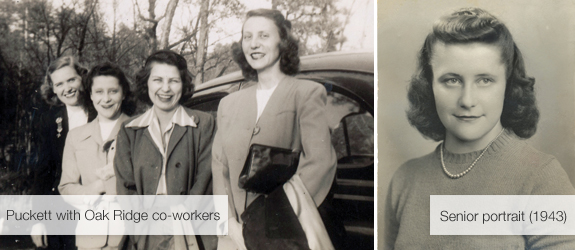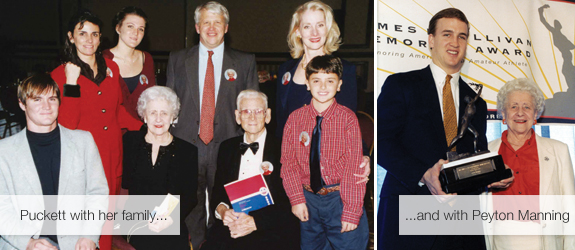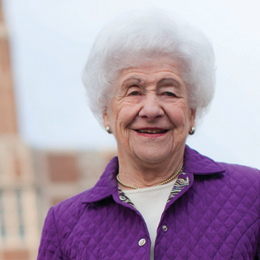Photo by Jack Parker
She kept it under her hat for years, but now, UT’s first statistics graduate discusses how she did her part for the U.S. war effort in the 1940s, including her work with the top-secret Manhattan Project.
How’s this for a job description? Manage the compilation of data obtained from a mass spectrometer used to separate uranium-235 from natural uranium and use the appropriate equations to calculate the percentage of uranium-235 obtained. Oh, and this is top-secret, by the way.
Kind of different from your 9 to 5, perhaps?
But that’s just what Jane Greer Puckett (’43) did every day when she launched her career in the 1940s at the Y-12 laboratories in Oak Ridge as part of the legendary Manhattan Project. The U.S. government’s top-secret project ultimately led to the development of the first atomic bomb, dropped on Hiroshima, Japan, in 1945, in a controversial effort to bring the conflict between the United States and Japan to a definitive close.
World War II defined Puckett’s time as a UT Knoxville student, as the campus changed to reflect the large number of young men sent abroad to fight. Despite the deficit of males, young women were still not allowed to enroll in some programs at the university.
“My desire was to sign up for engineering at UT,” Puckett says, “but women were not being accepted [to the program].”
A native of Paris, Tennessee, Puckett had transferred to UT in 1942 from Judson College in Alabama, carrying enough credits in engineering, mathematics, and physics to normally warrant her a spot in the engineering program. Being refused entry to the program because of her sex was unfortunate, but Puckett didn’t let it stop her.
“A person helping with registration told me to talk to Dr. Paul Barnett in the School of Business Administration about statistics,” she says. While it wasn’t engineering, statistics was definitely heavy on math, at which Puckett was very adept. Her academic skills were put to good use in UT’s role in the war effort.
“I had the pleasure of being asked to teach the young cadets that were joining the army and going to UT,” Puckett says, referring to the university’s participation in the Army Specialized Training Program. The program offered military men instruction in engineering, science, math, and foreign languages. On the flip side, the program helped save UT and other colleges and universities from shutting down due to the severe loss of students to the draft. UT offered a similar program for Air Force cadets.
“With all those cadets on campus, there was crowding in the dorms,” says Puckett, who lived in Strong Hall. “But that was our life. We were in a war, and we were dedicated to that war.”

In August 1943, Puckett became the first person to graduate with a statistics degree from UT. Her background in the field helped her land her first job and gave her the opportunity to help the United States’ war efforts.
“I went immediately to Oak Ridge,” says Puckett, who was offered a job as a statistician at Y-12 at what was then the Clinton Engineering Works. “It was a new city and fascinating to many people.”
In her position, Puckett supervised anywhere from eight to 40 clerks at a given time. Her staff obtained data from the work of socalled “calutron girls,” who operated the mass spectrometers to separate uranium-235 from natural uranium in a process called electromagnetic isotope separation. Puckett managed the compilation of the data, and her staff calculated the percentage of uranium- 235 obtained during the isotope separation process. Their computations were then sent to another area in the facility.
“The data were collected by authorities with high-level security guards,” Puckett says. “And if you threw a piece of paper away, it had to go in a red basket. They told us to leave it alone, and don’t do anything with it. … It was all very top-secret.
“We knew to keep our mouths shut and to work hard,” she says. “It became very interesting to me that my work would somehow help the war effort.”
Because of the “hush-hush” secrecy, Puckett and her co-workers didn’t realize the ultimate result of their work: The uranium-235 obtained at Y-12 and other facilities was used in the atomic bomb dropped on Hiroshima.
“It was exciting to be involved in something as secret as it was,” says Puckett, who made $35 each week and still has every one of her paystubs. “I was enamored of the position I had. … My background at UT was very helpful and gave me a good start.”

After her work at Y-12, Puckett stayed in Oak Ridge and continued to utilize her statistics and mathematics experience through her work with Dr. William K. Ergen at the X-10 Graphite Reactor, which helped develop peacetime uses for atomic energy.
Since her time in Oak Ridge, Puckett has spent a lifetime championing athletics and young athletes as a volunteer administrator of the Amateur Athletics Union (AAU). She ultimately was inducted to the Tennessee Sports Hall of Fame in 2002. Puckett and her husband Jim were inducted to the Tennessee Swimming Hall of Fame in 1986.
Puckett now lives in Tullahoma and is a mother of three and grandmother of three. At 88 years old, she stays active in social and civic organizations and loves sharing memories of her contributions to the Manhattan Project. Who can blame her? It had to be hard to keep exciting work like hers a secret for so long.


10 comments
To: Ms. Jane Greer Puckett
I enjoyed reading about your experience at the University of Tennessee on your way to Y-12 in the 1940’s. My dad, Harold B. Greene, worked with the Y-12 calutrons in the 40’s and I suspect you knew him. In June 2009 PBS produced a show, History Detective, about my dad and the mystery around a formerly-secret patent he held jointly with Michael K. Kudravetz concerning the calutron operations.
I was impressed that you did not let the Engineering School keep you from accomplishing your goal. You are an inspiration to those who meet with frustrations in their eucational endeavors.
Sincerely, Joan Greene Patterson
What an interesting career you had. I didn’t know any of this when I was growing up in Tullahoma. I knew you, of course, and am very proud of your accomplishments.
Anne Emmons Wall
Is Ms. Jane Greer Puckett related to a William Greer Puckett who also came from Tullehoma? When I was a graduate student at U.T.K.’s History Dept. from 1978 to 1980 pursuing my Master’s degree, I knew a fellow graduate student in the History program by that name before he moved on to accept an engineering job somewhere in Michigan. In fact, he was in the Introduction to Historical Research course with me that the late Dr. Leroy Graf taught. Since the early 1980’s, I have completely lost touch with him, and I subsequently moved on to accept work in New England, and then later in Albuquerque, where I currently reside. I hope he’s doing okay in his career.
Hi Bill,
I often wonder where you have been and where you are. I live in Bremerton, WA. Contact me at greerp1975@aol.com.
Greer
My mother, Cora Lucille Stanley, also worked at Y-12 in the Calutron Area, and I wonder if Ms. Puckett knew her? I am always looking for more information on my mom and what she did at Oak Ridge during that time. She rarely spoke of those times, but I have many mementos she kept from that time, including a certificate from Eastman Engineering and photos. At the same time she was working there, my dad was serving with the Marines in the South Pacific, so they saw both sides of WWII, on the field of battle and at home in the defense plant at Y-12.
If she sees this and did know my mother, I would love to hear from her.
I’m doing a research paper on Ms. Greer for my women’s studies course, specifically on women who weren’t forced out of their jobs after WWII – Is there any other material on Ms. Greer?
Thanks. My mother, Jane G. Puckett, is featured in a new book: http://www.girlsofatomiccity.com/
She is an acvanced dementia patient now in S. Pittsburg, TN.
All the best, HB Puckett
I enjoyed the article “Home Front Confidential” I worked at Oak Ridge at the K-25 plant in the late seventies. Our primary task, like Ms Puckett’s, was doing isotopic ratio work on uranium, using mass spectrometers. I worked in the early days of using computers to do the calculations and data logging. I am amazed, and humbled, that these mathematicians / statisticians did this analysis work without the computer.
I see where the uranium enrichment projects at various points around the globe keep this uranium analysis business still of a political and technological interest.
Wyatt Kilgallin
P.S. I graduated from UTK in 1983 with a Masters Degree in Engineering Science and Mechanics. I remember fondly my time in Tennessee
Thanks. My mother, Jane G. Puckett, is featured in a new book: http://www.girlsofatomiccity.com/
She is an acvanced dementia patient now in S. Pittsburg, TN.
All the best, HB Puckett
Thanks for the feedback, everyone.
R Christensen: If you’ll e-mail me at torch@tennessee.edu, I can provide you with additional information for your women’s studies course.